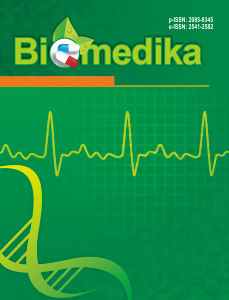Affinity of Chlorogenic Acid as COVID-19 Antiviral with Molecular Docking Method
DOI:
https://doi.org/10.23917/biomedika.v16i1.4622Keywords:
COVID-19, Affinity, Molecular Docking, Chlorogenic AcidAbstract
Due to the continued presence of and impact of COVID-19 on our modern world, the benefit and necessity of alternative treatment options and effective antiviral compounds is readily apparent. This study seeks to explore the utility of chlorogenic acid as a COVID-19 antiviral. The in-silico experimental study was conducted using a laptop and publicly-available freeware. Key compounds used in this study are the comparative drugs favipiravir (CID 492405), oseltamivir (CID 65028), nafamostat (CID 4413), and spironolactone (CID 5833), to be tested against our subject, chlorogenic acid (CID 1794427). Compunds used in this study were docked with specific target proteins, such as ACE2, TMPRSS2, RdRp, dan 3Clpro, using AutoDock Vina. The visualization of molecular interactions was performed with Discovery Studio v21. Our results showed that chlorogenic acid has one Lipinski’s Rule of Five violation in H-bond Donor parameter. Chlorogenic acid had a higher affinity towards ACE2 and 3CLpro and lower affinity towards TMPRSS2 and RdRp, if compared to competing drugs, with a binding energy of -7.8, -6.9, -7.0, and -7.4 kcal/mol respectively, for ACE2, TMPRSS2, RdRp, and 3CLpro. We conclude that chlorogenic acid shows promise as oral drug candidate based on these results, and that further studies into the realm of molecular dynamics, in-vitro, or in-vivo studies are warranted in order to explore this underutalized compound and possibly bring it to human trials.
Downloads
Downloads
Submitted
Accepted
Published
Issue
Section
License
Copyright (c) 2024 Biomedika

This work is licensed under a Creative Commons Attribution 4.0 International License.












